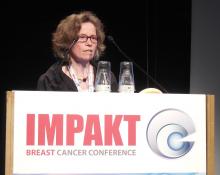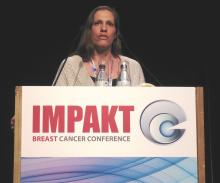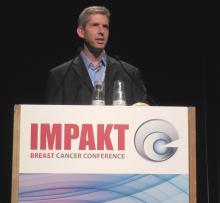BRUSSELS – A pair of breast cancer biomarkers look promising for making better prognosis assessments of selected patients, but acceptance of both into practice will need further documentation of their clinical utility, declared a senior breast cancer oncologist who served as discussant for the studies.
One of the markers is high intratumor heterogeneity of estrogen receptor density, a flag of poor prognosis when heterogeneity is high. The second marker is the phosphorylated signal transducer and activator of transcription (pSTAT) 3, which appeared to link with good prognosis in estrogen receptor–positive breast cancer.
Both markers already appear to have analytic and clinical validity based on two independent reports at a breast cancer conference sponsored by the European Society for Medical Oncology, Sabine C. Linn, MD, said as the designated discussant. The data on intratumor estrogen-receptor heterogeneity “is a very intriguing observation. If its validity is confirmed, it would be a very useful assay, with the advantages of being both cheap and not needing additional tests” to confirm a poor prognosis, said Dr. Linn, a professor of medical oncology and specialist in molecular pathology at the Netherlands Cancer Institute. The evidence reported for pSTAT3 showed that expression “strongly correlated with disease-free survival” that could potentially serve as a “warning sign before embarking on STAT3 inhibitor studies in the adjuvant setting,” she suggested.The data on intratumor estrogen-receptor heterogeneity came from specimens collected from the low-risk breast cancer patients enrolled in the Stockholm Adjuvant Tamoxifen trial during 1976-1990 (Acta Oncol. 2007 July 8;46[2]:133-45). Enrolled patients had lymph node–negative disease and primary tumors smaller than 30 mm. During the trial, researchers preserved formalin-fixed tumor specimens in paraffin from 778 patients, which formed the basis for the current study, explained Linda S. Lindström, PhD, a cancer epidemiologist at the Karolinska Institute in Stockholm. Slides from the specimens were restained for their estrogen receptor content in 2014 and assessed by two independent breast cancer pathologists. They scored the heterogeneity of estrogen receptor distribution as high, medium, or low, and Dr. Lindström and her associates calculated a hazard ratio for 25-year patient survival when they compared 593 specimens with high or low receptor heterogeneity. They adjusted the hazard ratios for several baseline variables including age, year of breast cancer diagnosis, HER2 status, Ki67 status, tumor grade, tumor size, randomization to tamoxifen or placebo treatment, and other factors.
The analysis showed that women with high intratumor estrogen receptor heterogeneity had nearly twice the rate of long-term breast cancer–specific death, compared with women who had low receptor heterogeneity (P less than .0001). A second adjusted analysis that focused on specimens from 336 of these women with luminal A tumors showed that high receptor heterogeneity linked with a hazard ratio of 2.4 for long-term cancer-specific death, compared with women with low-heterogeneity tumors (P = .011).
“Routine clinical assessment of intratumor heterogeneity of estrogen receptor may identify patients at high long-term risk for fatal breast cancer that may potentially change clinical management, especially for patients with luminal A subtype tumors,” Dr. Lindström said.“I’d like to see the C statistic; will the prognostic model improve significantly with this added?” Dr. Linn wondered. “We need at least two more independent validations.”
The second biomarker study used two separate analyses of pSTAT3 expression. The first involved specimens collected from 3,074 patients with luminal breast cancer. Analysis of pSTAT3 gene signature expression showed that, the higher the expression levels were, associated with better relapse-free survival during follow-up out to as long as 8 years, reported Amir Sonnenblick, MD, an oncologist at the Sharret Institute of Oncology of Hadassah-Hebrew University Medical Center in Jerusalem.
To confirm and extend this finding, he and his associates used data and specimens collected in the Breast International Group 2-98 phase III trial, which tested the effect of adding docetaxel, either in sequence to or in combination with anthracycline-based adjuvant chemotherapy, in women with node-positive and estrogen receptor–positive breast cancer (Euro J Cancer. 2015 Aug;51[12]:1481-9). The current analysis used 610 tumor specimens from among the 2,173 pathology specimens collected in the study and assessed pSTAT3 protein expression and correlated that with outcomes during a median 10.1-year follow-up. The new pathology review found some level of pSTAT3 in tumor or stroma of 174 (29%) of the 610 specimens examined.
Univariate analysis showed that binary pSTAT3 expression (positive or negative) significantly correlated with 10-year overall survival, with a hazard ratio of 0.66 (P = .04) for patients with positive expression, compared with those with no pSTAT3 expression, Dr. Sonnenblick said.
“pSTAT3 is associated with improved outcome in estrogen receptor–positive breast cancer. Future trials should take pSTAT3 status into account,” he concluded.
Dr. Linn cautioned that pSTAT3 expression should not be used to identify patients who can forgo chemotherapy, as the gene signature expression analysis showed that, even among patients with high pSTAT3 expression, long-term survival was still less than 90%.
Dr. Lindström and Dr. Sonnenblick had no disclosures. Dr. Linn has been an adviser to AstraZeneca, Cergentis, IBM Health, Novartis, Pfizer, Phillips Health, Roche, and Sanofi.
mzoler@frontlinemedcom.com
On Twitter @mitchelzoler



